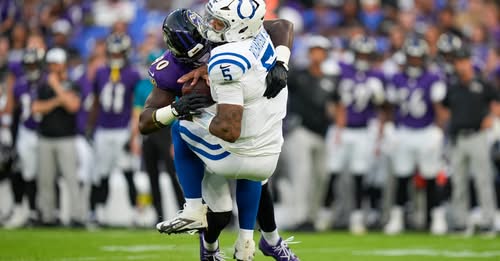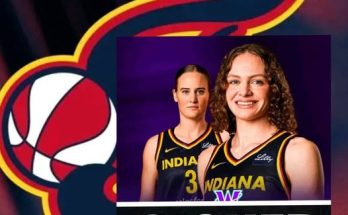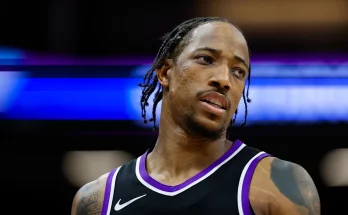Indianapolis Colts fans held their breath during a tense moment in the team’s matchup against the Baltimore Ravens when starting quarterback Anthony Richardson Sr. was forced to leave the game due to a painful finger injury. The incident unfolded in a contest that had already carried significant weight for both teams, as each was looking to make a statement in the early part of the season. Richardson, who has been viewed as a cornerstone of the Colts’ offense and a pivotal figure in their rebuilding efforts, had entered the game with high expectations after showing flashes of brilliance in previous weeks. Unfortunately, his night was cut short in a moment that seemed sudden but carried major implications for Indianapolis moving forward.
The injury occurred in the middle of an offensive series where Richardson was attempting to keep a promising drive alive. After taking the snap and scanning the field, he was forced to adjust under pressure as the Ravens’ pass rush collapsed the pocket. In the midst of the scramble, he attempted to release the ball quickly, but as his throwing motion completed, his hand made contact with either a helmet or an awkward point of impact that left his finger visibly damaged. Cameras caught Richardson wincing immediately and shaking his hand as he tried to assess the severity. Trainers were quick to rush over, and after a brief on-field evaluation, it was determined that he would head to the sidelines for further examination.
Fans in the stands and watching at home knew something was wrong when Richardson, known for his competitive spirit, didn’t try to argue his way back into the huddle. Instead, he walked slowly toward the bench with his throwing hand tucked against his body. The Colts’ medical staff quickly wrapped the finger, but the discomfort was apparent. Moments later, team officials confirmed that Richardson would not return for the remainder of the game, an announcement that dampened the mood in Lucas Oil Stadium.
Richardson’s exit not only shifted the tone of the game but also altered the Colts’ offensive strategy on the fly. Backup quarterback Gardner Minshew was called upon to step in and try to keep the momentum alive against one of the league’s most disciplined defensive units. Minshew, a capable veteran, faced an uphill battle as the Ravens adjusted to pressure the new quarterback and disrupt any rhythm Indianapolis tried to build. While Minshew managed some promising plays, it was clear that the Colts’ offense was no longer operating with the same explosiveness that Richardson brings with his unique combination of arm strength, mobility, and creativity.
The loss of Richardson for the night raised immediate questions about the severity of the injury. The Colts have been cautious with their young quarterback, given his importance to the team’s long-term vision. After battling injuries earlier in his career, Richardson has been working to establish himself as both a reliable passer and a durable leader in the huddle. This setback, even if temporary, is a reminder of the fine line NFL players walk between heroics and health. Every snap carries a level of risk, especially in a high-contact position like quarterback, where even a minor injury can derail a season’s momentum.
From a strategic standpoint, Richardson’s absence also brought attention to the Colts’ depth chart and their offensive adaptability. The team has invested heavily in designing a scheme that takes advantage of Richardson’s dual-threat capabilities. His ability to extend plays and make defenses respect both the run and pass has been a cornerstone of their game plan. Without him, the Colts were forced to lean more heavily on short passes, quick reads, and traditional pocket play, which played into the Ravens’ defensive strengths. Baltimore’s secondary, already adept at limiting big plays, tightened its coverage and forced Indianapolis into methodical drives that demanded near-perfect execution.
As the game progressed, the psychological effect of losing their leader became evident. Players who had been energized by Richardson’s presence now had to dig deep to maintain focus and belief. To their credit, the Colts showed resilience, but the absence of their starting quarterback was a hurdle that loomed large over the final quarters. Fans could sense the change in energy, and while support for Minshew was genuine, the reality was that Indianapolis had lost one of its most dangerous weapons.
In the postgame press conference, head coach Shane Steichen addressed the injury with a mix of concern and cautious optimism. He acknowledged that Richardson had been in visible pain and that the decision to hold him out for the rest of the game was made with his long-term health in mind. Steichen emphasized that the team’s medical staff would conduct further tests to determine the extent of the injury, noting that X-rays and other imaging might be needed. While he stopped short of providing a specific timeline, Steichen’s tone suggested that the team would prioritize recovery over rushing Richardson back.
Richardson himself, despite the obvious frustration of leaving the game, was composed in his comments to reporters. He explained that he felt something immediately after the play and knew he couldn’t grip the ball the way he needed to in order to be effective. His maturity in handling the situation underscored why the Colts have placed so much trust in him as the face of the franchise. Even in a disappointing moment, he shifted the focus to the team’s effort and praised Minshew for stepping in under difficult circumstances.
From a broader perspective, this injury incident serves as a reminder of the volatility of an NFL season. The Colts entered the year with hopes of competing for a playoff spot, relying heavily on Richardson’s continued development and ability to make plays that few quarterbacks can. Every game without him represents not only a challenge in the standings but also a test of the team’s ability to adjust and find new ways to win. Injuries are an inevitable part of football, but losing a quarterback with Richardson’s skill set is particularly impactful because it forces an entire offensive identity to be reimagined.
For Colts fans, the immediate concern is whether Richardson will miss extended time. The schedule does the team no favors, with several tough opponents ahead who will test every aspect of Indianapolis’ roster. If Richardson’s injury proves minor and he can return soon, the damage to the season’s outlook might be limited. However, if it sidelines him for multiple weeks, the team will have to navigate a difficult stretch without their primary offensive catalyst. This could also put increased pressure on the running game, led by Jonathan Taylor, to shoulder more of the load and open up opportunities for Minshew or another backup to succeed.
The Ravens, for their part, did what veteran teams do — they adapted quickly and exploited the sudden change in Indianapolis’ personnel. Baltimore’s defense tightened its grip, while their offense maintained steady drives that kept the Colts’ defense on the field and drained the clock. While Richardson’s departure was a blow to Indianapolis, it was also a testament to Baltimore’s ability to pounce on opportunities and close out games against shorthanded opponents.
As fans await official updates on Richardson’s condition, speculation will naturally run rampant. Social media lit up immediately after the injury, with fans, analysts, and former players weighing in on what it could mean for the Colts’ season. Some noted that hand and finger injuries can range from relatively quick recoveries to lingering problems that affect a quarterback’s mechanics. Others pointed out that Richardson’s style of play — which often involves extending plays and taking hits — inherently carries more injury risk. The key moving forward will be balancing his dynamic abilities with strategies that protect him from unnecessary harm.
For now, the Colts face a period of uncertainty, one in which their resilience and adaptability will be tested. The hope is that Anthony Richardson Sr.’s finger injury is nothing more than a temporary setback, allowing him to return to the field and continue building on the promise he has shown. In the meantime, Indianapolis will rally around whoever takes the snaps, knowing that in the NFL, success often depends on the entire roster stepping up when adversity strikes.
If Richardson returns quickly and healthy, this moment may ultimately be remembered as just a minor bump in the road of his career — a reminder of his toughness and the team’s ability to withstand challenges. But if the injury lingers, it could become a pivotal turning point in the Colts’ season, influencing everything from their offensive strategy to their place in the playoff race. Until then, the image of Richardson walking to the sideline, his finger wrapped and his expression resolute, will stick in the minds of Colts fans as they await the next chapter in their quarterback’s journey.



